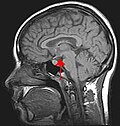cell nucleus (from Latin nucleus or nuculeus 'kernel, seed'; pl.: nuclei) is a membrane-bound organelle found in eukaryotic cells. Eukaryotic cells usually...
87 KB (9,883 words) - 21:56, 26 April 2024
motility. Cells are broadly categorized into two types: eukaryotic cells, which possess a nucleus, and prokaryotic cells, which lack a nucleus but have...
61 KB (6,320 words) - 14:00, 7 May 2024
nucleus, the very dense central region of an atom Cell nucleus, a central organelle of a eukaryotic cell, containing most of the cell's DNA Nucleus may...
3 KB (362 words) - 16:42, 11 April 2024
A nucleated red blood cell (NRBC), also known by several other names, is a red blood cell that contains a cell nucleus. Almost all vertebrate organisms...
7 KB (642 words) - 07:10, 18 July 2023
consists of taking a denucleated oocyte (egg cell) and implanting a donor nucleus from a somatic (body) cell. It is used in both therapeutic and reproductive...
50 KB (6,146 words) - 06:46, 27 May 2024
Soma (biology) (redirect from Cell body)
Dendrite Soma Axon Nucleus Node of Ranvier Axon terminal Schwann cell Myelin sheath In cellular neuroscience, the soma (pl.: somata or somas; from Greek...
6 KB (797 words) - 15:24, 4 March 2024
muscle cells have a single nucleus. The unusual microscopic anatomy of a muscle cell gave rise to its terminology. The cytoplasm in a muscle cell is termed...
37 KB (4,515 words) - 23:27, 19 March 2024
Mitochondrion (redirect from Cell powerhouse)
cristae, and matrix. Although most of a eukaryotic cell's DNA is contained in the cell nucleus, the mitochondrion has its own genome ("mitogenome")...
158 KB (17,635 words) - 03:28, 27 May 2024
capillary network. In humans, mature red blood cells are flexible biconcave disks. They lack a cell nucleus (which is expelled during development) and organelles...
64 KB (7,808 words) - 08:06, 20 May 2024
eukaryotic cells by the absence of a cell nucleus or other membrane-bound organelle. Prokaryotic cells are much smaller than eukaryotic cells, making them...
42 KB (5,258 words) - 12:11, 16 May 2024
Epithelium (redirect from Epithelial cell)
(3); an uninfected cell shown at (2) and (4) showing the difference between an infected cell nucleus and an uninfected cell nucleus. Epithelium grown in...
32 KB (2,885 words) - 14:27, 12 May 2024
Protein biosynthesis (section Sickle cell disease)
mature mRNA. The mature mRNA is exported from the cell nucleus via nuclear pores to the cytoplasm of the cell for translation to occur. During translation...
40 KB (4,342 words) - 18:58, 2 April 2024
Barr body per somatic cell nucleus, while a genotypical male (46, XY) has none. The Barr body can be seen in the interphase nucleus as a darkly staining...
10 KB (1,142 words) - 22:42, 2 March 2024
Mitosis (redirect from Mitotic cell division)
chromosomes divide within an intact cell nucleus. Most animal cells undergo a shape change, known as mitotic cell rounding, to adopt a near spherical...
71 KB (7,313 words) - 09:44, 17 May 2024
Nuclear envelope (section Cell division)
is made up of two lipid bilayer membranes that in eukaryotic cells surround the nucleus, which encloses the genetic material. The nuclear envelope consists...
18 KB (2,035 words) - 21:20, 12 April 2024
strands unitedly called “double helix”. In eukaryotes, DNA consists of a cell nucleus and the DNA is providing strength and direction to the mechanism of heredity...
55 KB (5,949 words) - 18:00, 24 March 2024
Nucleoplasm (category Cell anatomy)
the type of protoplasm that makes up the cell nucleus, the most prominent organelle of the eukaryotic cell. It is enclosed by the nuclear envelope, also...
16 KB (1,925 words) - 22:37, 21 March 2024
The solitary nucleus (also called nucleus of the solitary tract, nucleus solitarius, or nucleus tractus solitarii (SN or NTS)) is a series of sensory nuclei...
8 KB (876 words) - 02:07, 9 May 2024
Hypothalamus (redirect from Hypothalamic nucleus)
In mammals, magnocellular neurosecretory cells in the paraventricular nucleus and the supraoptic nucleus of the hypothalamus produce neurohypophysial...
48 KB (4,830 words) - 16:37, 11 May 2024
antinuclear factor or ANF) are autoantibodies that bind to contents of the cell nucleus. In normal individuals, the immune system produces antibodies to foreign...
54 KB (6,092 words) - 04:38, 22 April 2024
daughter cells in a process called cell division. In eukaryotic cells (having a cell nucleus) including animal, plant, fungal, and protist cells, the cell cycle...
77 KB (9,016 words) - 08:03, 24 May 2024
in every living cell of every life-form on Earth. In turn, they send and express that information inside and outside the cell nucleus. From the inner...
23 KB (2,743 words) - 08:13, 9 May 2024
two are prokaryotes, single-celled microorganisms without a membrane-bound nucleus. All organisms that have a cell nucleus and other membrane-bound organelles...
12 KB (1,294 words) - 12:43, 23 May 2024
Cytoplasm (category Cell anatomy)
In cell biology, the cytoplasm describes all material within a eukaryotic cell, enclosed by the cell membrane, except for the cell nucleus. The material...
16 KB (1,885 words) - 03:35, 16 April 2024
The dorsal nucleus of vagus nerve (or posterior nucleus of vagus nerve or dorsal vagal nucleus or nucleus dorsalis nervi vagi or nucleus posterior nervi...
3 KB (266 words) - 16:52, 5 September 2023
for each daughter cell. Eukaryotic organisms (animals, plants, fungi and protists) store most of their DNA inside the cell nucleus as nuclear DNA, and...
166 KB (17,853 words) - 12:58, 28 May 2024
Nuclear pore (category Cell nucleus)
found in the nuclear envelope of eukaryotic cells. The nuclear envelope (NE) surrounds the cell nucleus containing DNA and facilitates the selective...
25 KB (3,064 words) - 02:56, 24 May 2024
to the cells he was observing. Therefore, he did not think the "cellulae" were alive. His cell observations gave no indication of the nucleus and other...
26 KB (3,355 words) - 13:03, 26 April 2024
synthesized in cells from amino acids according to mRNA transcripts, which are synthesized from DNA templates inside the cell nucleus. Preprohormones...
5 KB (547 words) - 21:45, 20 January 2024
Biology (section Cell structure)
generally two types of cells: eukaryotic cells, which contain a nucleus, and prokaryotic cells, which do not. Prokaryotes are single-celled organisms such as...
132 KB (13,788 words) - 09:25, 9 May 2024
























